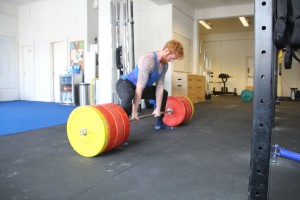When performing various exercises, it is often effective to use an anatomical breathing strategy where you match your breaths to suit the movements of the exercise. For example, if the movement involves a bending forward action before bringing yourself back up to an extended position (kettlebell swing), then it makes sense to exhale during the bending phase where your ribcage and stomach may feel a little compressed, and inhale when you are in an upright position where your ribcage can be easily elevated.
Anatomical breathing works well when working with moderate loads. However, as the loads increase, it makes more sense to utilise a breathing strategy that helps you to maintain greater tension in your trunk, which in turn minimises the risk of injury, while maximising performance.
The most popular method used when lifting heavier loads is often referred to as “biomechanical breathing”. This and “anatomical breathing” are terms I picked up from kettlebell training, but they describe breathing strategies well for all forms of resistance training.
During biomechanical breathing, the lifter matches their inhalation with the eccentric (downwards) phase of a lift and their exhalation with the concentric (upwards) phase of the lift, usually exhaling towards the latter stages of the concentric phase.
This breathing strategy is coupled with the use of the valsalva maneuver, which is best described as a moderately forceful attempted exhalation against a closed airway (like when you depressurize your ears when holding your nose). This, combined with bracing (engaging) your core musculature creates intra-abdominal pressure (IAP) which helps stabilise the spine (imagine the rigidity of a closed plastic bottle full of air compared to an open bottle).
Biomechanical breathing is an effective strategy. However, we often take this further by inhaling prior to the lift being started and exhaling once the lift is completed. Although, this (along with the valsalva maneuver) can cause a rise in blood pressure and in turn dizziness. When working with heavy loads, it makes sense to maximise trunk stability throughout the entire lift. Essentially, the risk of musculoskeletal injury and the need for greater performance generally outweigh the risks of holding your breath during an individual rep (we are talking about individuals with no health issues here).


